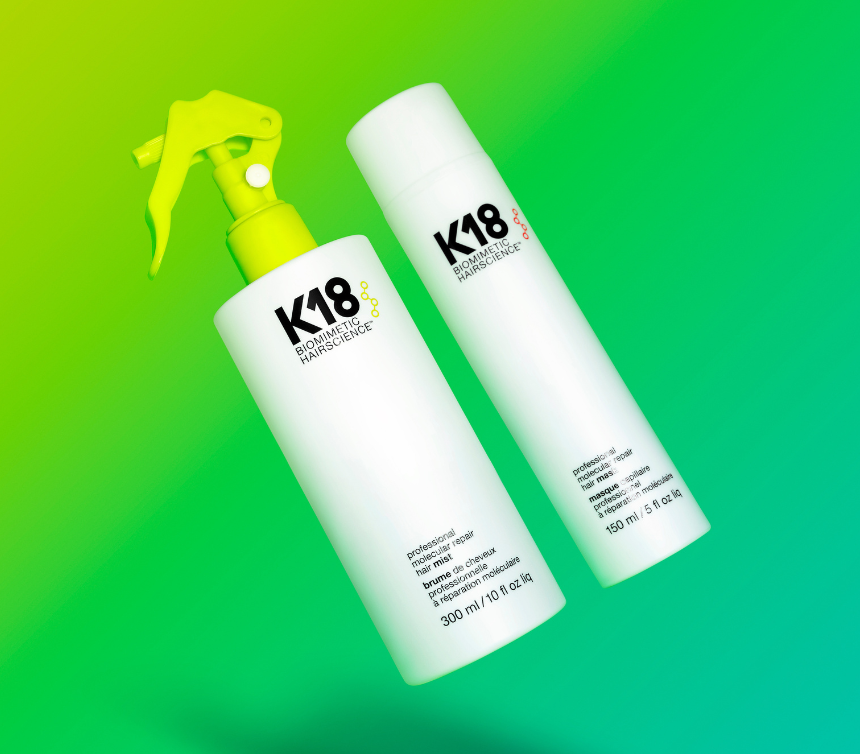We love pH. And not just because we’re science nerds but because in so much of our research, we’ve found an optimal pH balance is one of the keys to your healthiest hair.
Let’s start with a quick reminder from the introduction to pH we shared last year. Your hair proteins have their very own pH (around 3.7) and how that interacts with its surrounding environment can play a significant role in hair’s overall health. Hair has an optimal pH range of 4.5–5.5, meaning that when it is in an environment (say exposed to water or conditioner) with this pH, its proteins are in their happiest, most resilient state. Scalp, too, has an optimal pH of around 5.5 and is a self-regulating environment, meaning without any outside factors introduced, your body has everything it needs to keep this range in check and prevent the overgrowth of things like fungi and bacteria.
Introducing something foreign or something not optimized with the same pH level as your natural range can throw the pH all out of whack. When the range is imbalanced (as can happen with things like products) both hair and scalp become vulnerable.
Optimal pH for Hair
When the hair fiber is within range, its structure is most resistant to damage. At optimum pH, the acidic groups of amino acids are negatively (–) charged, and the basic groups are positively (+) charged. These opposite charges attract each other, creating ionic bonds or “salt linkages” that contribute to the fiber’s strength. Hair proteins are in their best condition and exhibit the best thermal stability when kept within this range.
When the pH environment of the hair drops below or exceeds this range, its structural integrity is compromised and damage may occur.
Unfortunately, we’ve found this knowledge hasn’t really translated over to the haircare industry. pH range isn’t something enough formulators or companies really pay close attention to, which means most products they’re making (and asking you to buy) aren’t optimized to keep your hair and scalp in balance.
The compounding issue with this is just from wetting + rinsing hair, pH is often thrown off balance. Since most tap water is in the range of 6.5-9.5 (ALL above hair’s optimal pH) it’s even more important to use lower pH products like shampoo, conditioner, or leave-ins to help offset that exposure to higher pH. But, most of those products? Usually not correctly optimized to help the issue.
For the sake of this argument, we’re going to isolate our findings to one type of product pretty much everyone is using no matter their routine: shampoo. We’re going to break down shampoos formulated at everything from optimal pH (where your hair is happiest) to alkaline pH (danger zone) to see how it’s impacting hair. The thing to remember throughout is that the swelling behavior of the hair cuticle is highly dependent on pH—the more alkaline the environment, the greater the degree of swelling.
Shampoos with optimal pH of 4.5-5.5
This range is where your hair is the happiest and healthiest.
Proteins in hair are in an optimal state (most structurally resilient) around a pH of 5. This more acidic pH environment also minimizes excess swelling of the cuticle, reducing protein loss, preserving color, and minimizing electrostatic repulsion.
This is your hair with optimal pH
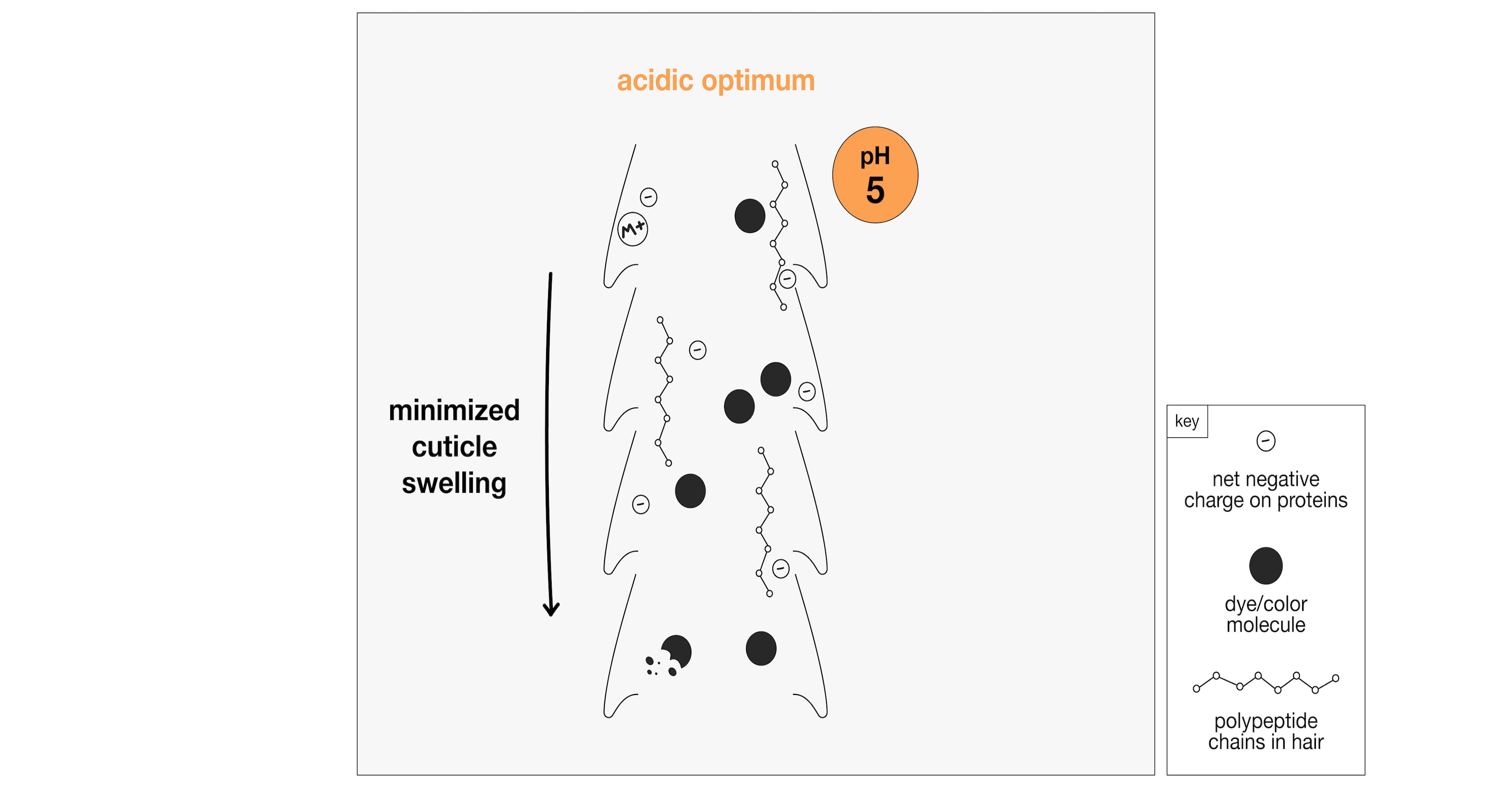
Lookin’ good.
Shampoos with near neutral pH of 6-7
This range isn’t the worst but tends to cause less-than-happy hair. This is where the cuticle starts to swell more than at an acidic pH. More raised cuticles lead to more internal exposure of all the stuff that’s inside.
This is your hair with neutral pH
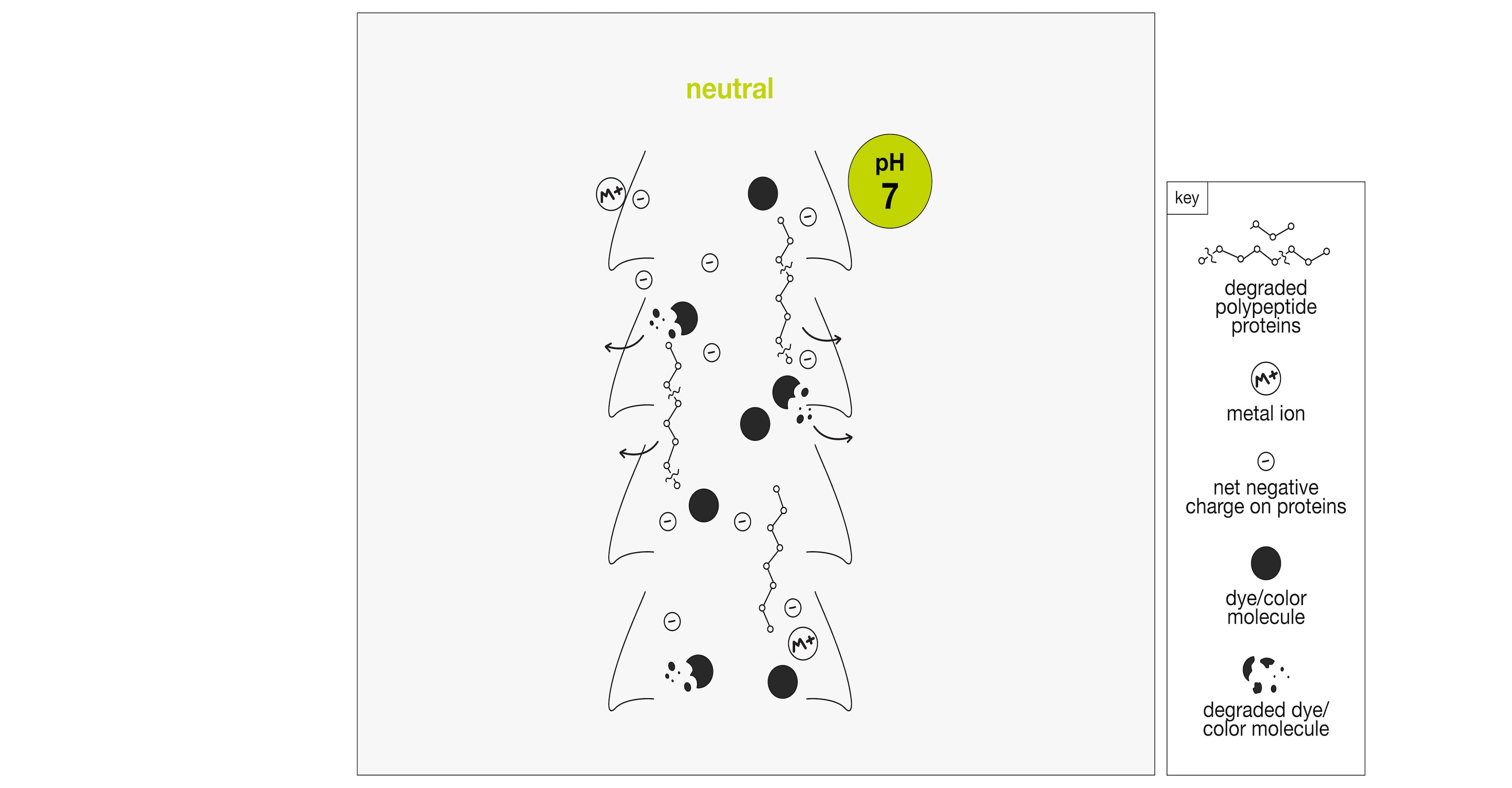
Ok, not the best, but not the worst either…
Shampoos with high pH of 8+
This range becomes a danger zone for problem hair.
Too high of a pH can cause even more swelling of the hair fiber. Think about those overextended cuticles, looking a lot like a pinecone, and how easily they can catch + snag on one another. More tangling, more force to brush, and ultimately more breakage.
Wash your hair with a shampoo that has a pH of 7.5 or higher and this causes the proteins to degrade more easily. This can also cause hair dye to fade faster and create a higher likelihood of hair breakage with mechanical and thermal styling tools—we’re talking everything from brushing to blow drying.
This is hair with alkaline pH
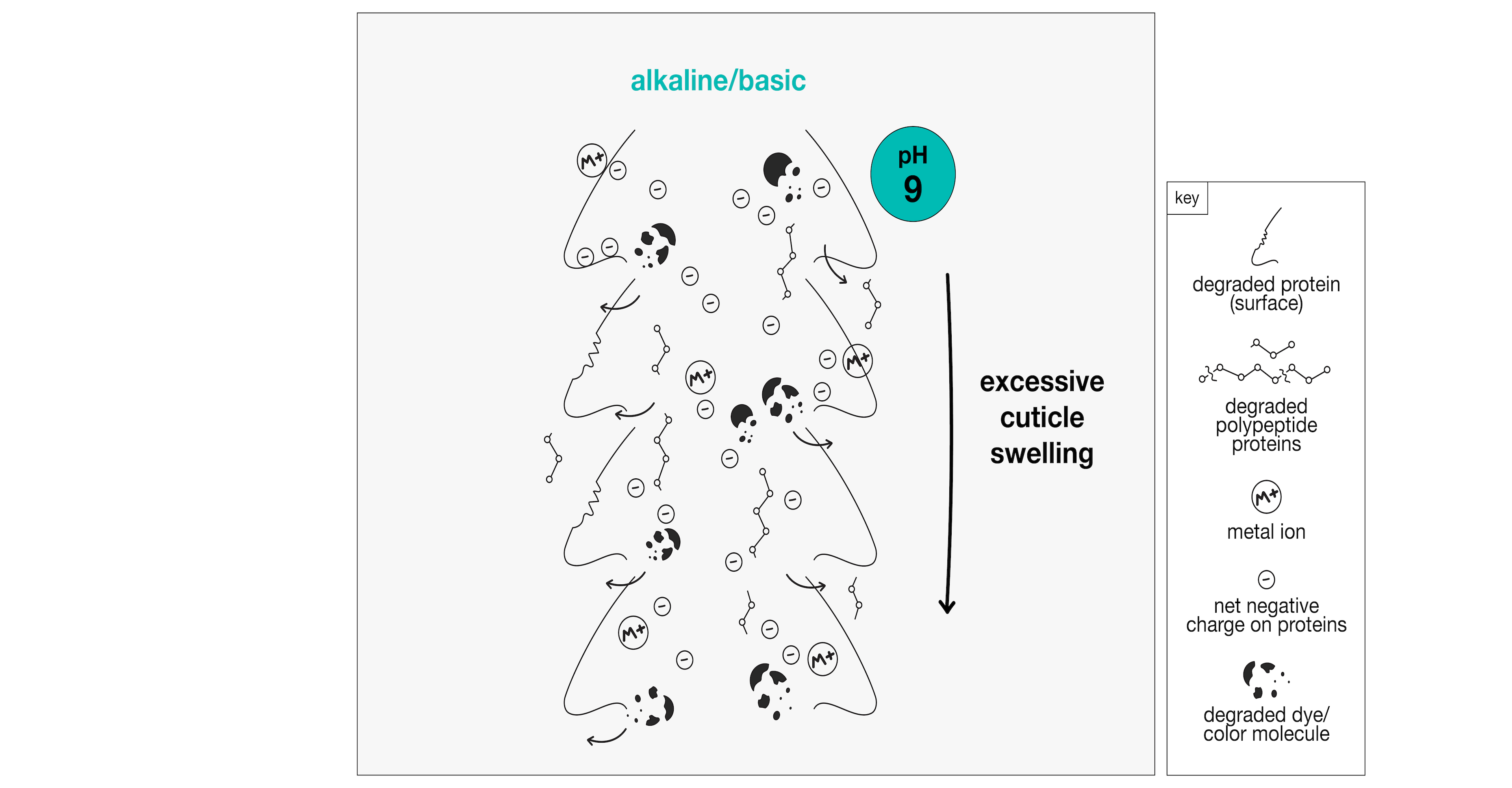
To offset these less-than-great effects of a too-high pH, formulators often load up with excessive use of conditioning agents to make the hair look and feel nice regardless of the high pH. Traditional shampoo formulas have added conditioning agents, exchanging dirt and sebum with emollients, cationics, and polymers to modify the surface properties of hair. These are used to offset the undesirable feel of cleaned hair and deposit a protective layer on the fibers. So not exactly leaving them “clean”.
The other important thing to note here is the more alkaline the pH, like the range above, the more minerals + metals that can bind to the hair, wreaking even further damage, impacting hair texture, and creating the potential for more damaging oxidative reactions (a refresher on those here).
a quick recap
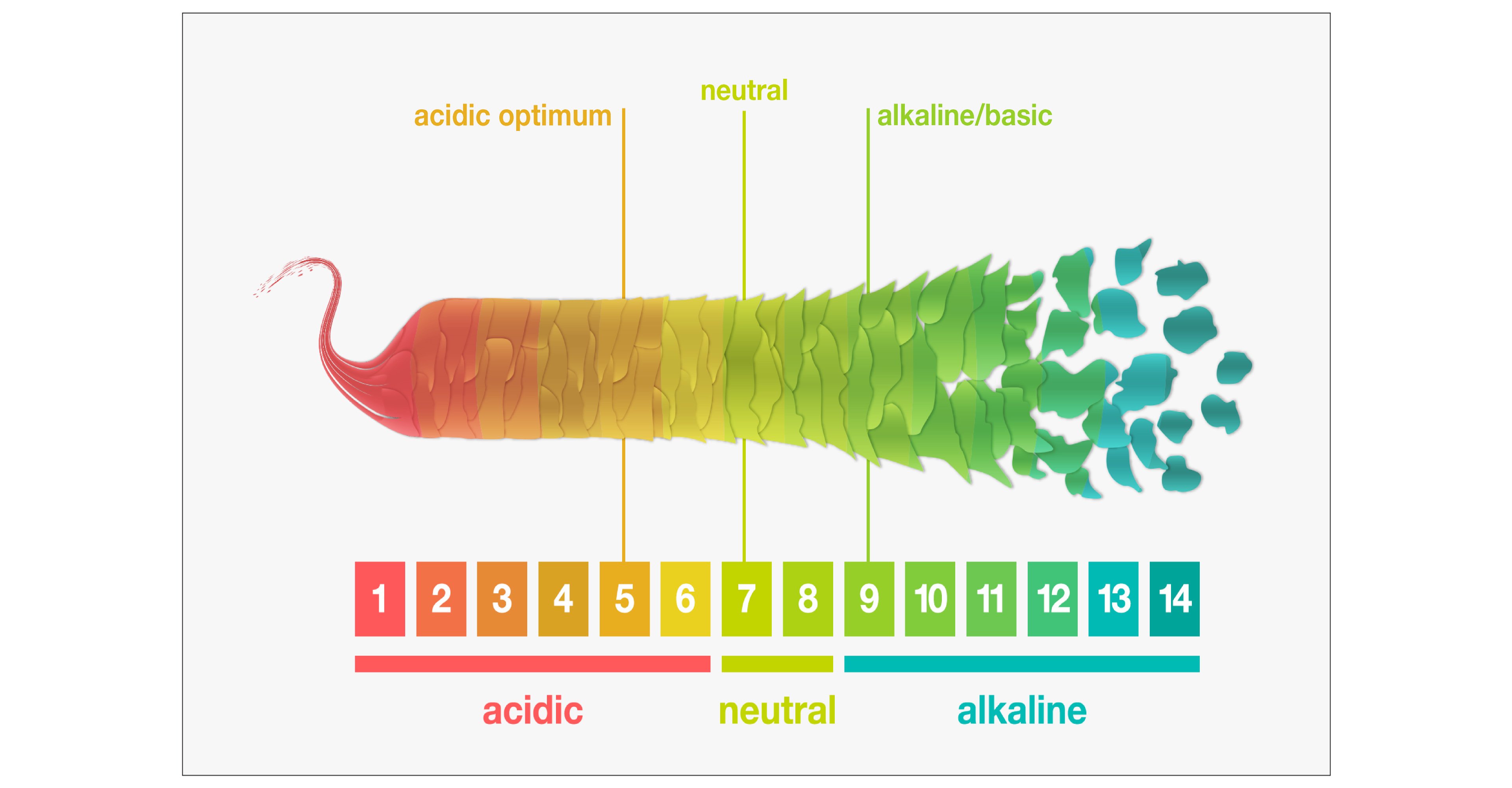
Formulating a product like shampoo at a more acidic pH can help counteract this alkaline pH environment and minimize the net negative charge on hair proteins, which minimizes cuticle swelling and also reduces binding sites for dissolved metal cations.
And on the topic of fillers we mentioned earlier, while having protective agents like emollients, occlusives, cationics, and polymers on the hair fiber can minimize friction and associated styling damage, excessive product buildup can weigh hair down and prevent additional products from performing as well.
Overall, products formulated right around that sweet spot of 4.5-5.5 keep the hair + scalp at equilibrium. They also offer the best protection for the hair fiber, your color, and any potential treatments or styling products you may want to use—without blockage from fillers used to offset more alkaline pH effects.
P.S.
If you like to nerd out like us, here are some of our references for even more pH deep diving.
Happy learning!
References:
- O’Connor, S. D., Komisarek, K. L., & Baldeschwieler, J. D. (1995). Atomic Force Microscopy of Human Hair Cuticles: A Microscopic Study of Environmental Effects on Hair Morphology. Journal of Investigative Dermatology, 105(1), 96–99. https://doi.org/10.1111/1523-1747.ep12313377
- Gavazzoni Dias, M. F., Pichler, J., Adriano, A., Cecato, P., & de Almeida, A. (2014). The shampoo pH can affect the hair: Myth or Reality? International Journal of Trichology, 6(3), 95. https://doi.org/10.4103/0974-7753.139078
- https://malibuc.com/products/un-do-goo-shampoo
- Robbins, C. R. (2016). Chemical and Physical Behavior of Human Hair. Springer.
- Rathi, S., & D′Souza, P. (2015). Shampoo and conditioners: What a dermatologist should know? Indian Journal of Dermatology, 60(3), 248. https://doi.org/10.4103/0019-5154.156355
- Malinauskyte, E., Cornwell, P. A., Reay, L., Shaw, N., & Petkov, J. (2020). Effect of equilibrium pH on the structure and properties of bleach‐damaged human hair fibers. Biopolymers, 111(11). https://doi.org/10.1002/bip.23401
- Zhou, Y., Foltis, L., Moore, D. J., & Rigoletto, R. (2010). Protection of oxidative hair color fading from shampoo washing by hydrophobically modified cationic polymers. International Journal of Cosmetic Science, 32(2), 158–159. https://doi.org/10.1111/j.1468-2494.2010.00534_12.x
- Ali, S., & Yosipovitch, G. (2013). Skin pH: From Basic Science to Basic Skin Care. Acta Dermato Venereologica, 93(3), 261–267. https://doi.org/10.2340/00015555-1531
- WHO Guidelines for Drinking Water Quality: pH in Drinking Water https://www.who.int/water_sanitation_health/dwq/chemicals/ph_revised_2007_clean_version.pdf
- Noble, R. E. (1999). Uptake of calcium and magnesium by human scalp hair from waters of different geographic locations. Science of The Total Environment, 239(1–3), 189–193. https://doi.org/10.1016/s0048-9697(99)00325-3
- Drinking Water Supply & Quality Report, NYC 2021 https://www1.nyc.gov/site/dep/about/drinking-water-supply-quality-report.page



